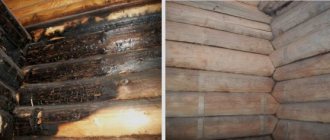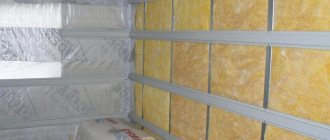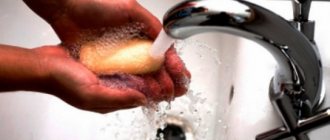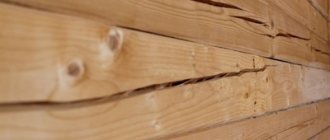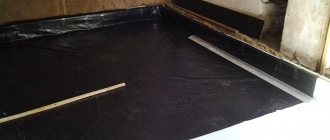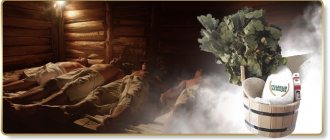Soot is an accumulation of products of incomplete combustion of carbon, resulting from the combustion of organic and inorganic substances. The accumulation of deposits on the inner surface of a fireplace, stove, pieces of furniture, interior decoration of housing and other premises after a fire negatively affects health, so it is important to understand in detail how you can wash off soot in a way that reduces cleaning time and minimizes the impact on the body.
Main recommendations
An important rule is to never use water or abrasive devices to clean wood walls. Immediately exclude such aids as:
- bleach or other chlorine-containing preparations;
- water;
- abrasive sponges;
- metal brushes;
- liquid soap;
- cleaning powders;
- sprayers;
- Karchers and steam cleaners.
Cleaning soot from the ceiling in a bathhouse Source alfaclean.by
Using a mechanical method to clean soot and deposits in a bathhouse Source remontnik.ru
When cleaning a bathhouse, be sure to follow safety rules and wear items of clothing that make contact with chemicals safe. These items include:
- working headdress (cap, headscarf, scarf);
- latex gloves;
- plastic buckets, basins (metal may oxidize);
- petal respirator (a four-layer gauze bandage is also suitable);
- robe;
- protective glasses.
When using special cleaning products for wood, be sure to read the instructions. Otherwise, you may harm the wood partitions.
Petal brush for cleaning wooden walls in a bathhouse Source ecosrub.ru
How to remove traces of soot on different surfaces
Since soot is a combustion product, it can be either dry, greasy or sticky. It depends on what material was being burned. To remove soot after a fire, you need to use harsh methods.
Do not rub contaminated areas with a cloth moistened with plain water. If you do this, the soot particles will clog into microcracks in the surface and remain there forever.
Advice! Carbon particles can enter the body through the respiratory tract and skin, having a detrimental effect on human health. Therefore, before starting work, you should put on a protective mask, headscarf, goggles and gloves. It is recommended to carry out work in clothes that can later be thrown away without regret.
If you are going to clean the walls or ceiling of soot, first cover the floor with newspapers or plastic wrap.
Causes of soot and soot
Smoke with soot appears due to the low combustion temperature in the furnace or an improperly organized traction system. In such cases, when the boiler door is opened, clouds of smoke will come out and be absorbed by the walls. There are a number of other reasons why soot accumulates:
- The chimney pipe becomes overgrown with soot or a foreign object gets inside, making it difficult to remove the soot.
- Errors in the construction of heating equipment. Incorrect slopes, incorrect location of the smoke exhaust duct and the design of the stove itself can cause soot to appear. Only a thorough modification of the sauna heating will correct the situation.
- Strong wind. If the weather is bad outside, the wind can blow into the chimney. This will cause smoke to escape in the opposite direction. In this case, soot on the walls is inevitable. Some designs include a ridge, but often if the wind direction is unfavorable, it is absolutely useless.
- The appearance of cracks in brickwork. New holes begin to draw air out of the oven from all sides. This causes smoke to escape from the firebox. Even if you manage to ventilate the room, soot will still fall on the surface of the wooden walls.
- Smoke. If, after a long break, the firebox is not preheated, then smoke penetration into the room is inevitable. To prevent this, before starting the kindling, throw a few newspapers or a rag doused with gasoline inside, then set it on fire.
Single-story baths are a common practice; accordingly, the smoke exhaust system will be located lower. Therefore, bad weather and other factors that prevent normal air circulation inside the stove will cause smoke inside the room.
Cleaning walls in a bathhouse with ammonia diluted with water Source dizainvfoto.ru
Brick
How to remove soot from a brick stove in a bathhouse? One of the most effective methods is to use a simple detergent and sponge. You need to take the detergent, dilute it with water and whisk until a thick foam forms. The treated surface should be left for 10-15 minutes, then rinsed with water. Another great way is to use vinegar essence. You will need tap water and table vinegar. For one glass of vinegar you need to take two glasses of water. Don't forget to use gloves! Apply the solution to the brick, leave for 10 minutes, then rinse thoroughly. How to wash off soot if it has penetrated deep enough into the brick pores? Vinegar can not be diluted with water, but simply applied to the masonry. Once the cleaning procedure is completed, use a soft brush and rinse the oven with clean water.
Source
Cleaning methods
Soot is very difficult to remove from wooden surfaces. For this purpose, two methods are used: mechanical and chemical.
Mechanical
All you need to do is dry the bathhouse thoroughly, ventilate it and make sure the walls are completely dry. All you have to do is be patient and use a stiff brush (not a broom, but the one you use to clean carpets, for example). Put on personal protective equipment and start cleaning.
Treatment of wooden surfaces in the bath after cleaning Source pk777.ru
Ready set after a fire
The advantage of such sets is their universal action. In addition to effectively washing away burning and soot, the product quickly removes unpleasant odors and poisons after a fire. However, during the cleaning procedure of the room, you need to close all windows and doors, otherwise the substance will simply disappear.
Many preparations differ in their use: some are diluted to form foam, while others can be used in the form in which you bought them. Therefore, before cleaning the apartment, carefully read the instructions for use and follow the recommendations.
Preparatory work before cleaning
Regardless of which method you want to use to remove soot from a bathhouse, you must first prepare.
- Clear the room of unnecessary items (towels, soap, various hygiene products).
- Wear protective clothing: be sure to wear gloves, a respirator, and goggles (choose special plastic ones with good transparency).
- Cover clean surfaces with polyethylene or any film to prevent dust and dirt from getting into these places.
- Take a broom and a hard-bristled brush and clean the top layer of dirt. Also remove all cobwebs and small debris from the coverings.
- After completing the steps, you can proceed to the main type of processing: mechanical or chemical method.
Elastic melamine sponge for removing soot from wooden walls in a bathhouse Source khoz-byt.rf
We suggest studying the list of expected materials and tools that will be required for the mechanical removal method:
- a long-handled brush-brush is suitable for removing dirt from crevices and corners;
- a sharp knife or knitting needles will help remove soot in hard-to-reach places: between logs, behind the stove;
- sandpaper with a fine degree of abrasiveness (it will help to carefully remove too fine dry soot without damaging the wood);
- A melamine sponge is suitable if there are small and non-permanent stains on the walls. This device acts like an eraser.
Please note that you can use folk remedies to clean soot from wooden walls. For example, crushed red brick. Its crumbs are rubbed onto walls in areas of contamination. This promotes removal. The spray can be applied to a dry cloth or sponge.
Brick chips for cleaning walls from soot in a bathhouse Source tennisitpro.rf
Complete cleaning of the apartment
After a fire in an apartment, almost all surfaces are contaminated with soot. Each material has its own contraindications for the use of cleaning agents; accordingly, each item requires a special approach to the choice of cleaning method and means.
Be sure to read:
How to remove fuel oil from a jacket or down jacket using folk remedies
Stages of apartment cleaning:
- Ventilation is a mandatory step.
- Removing remnants of cladding , painting walls, ceilings.
- Washing joints between bricks , concrete slabs, walls and window frames.
- The presence of intact coatings on the floor requires the use of plastic film; it will not allow soot, whitewash, or particles of old glue to settle on the floor.
- A broom will be needed not only for sweeping debris from the floor , but also for sweeping away the remains of dry combustion products from the walls.
- Treatment with professional means to eliminate the consequences of a fire should be carried out after preliminary preparation, which will reduce the consumption of expensive substances.
It is more convenient to wash small hard objects with a smooth surface in a bathtub with a foam solution. Upholstery upholstery can only be removed from stains and odors by washing.
There is a lot of work ahead, but simply covering up the fumes with new finishing materials is a bad decision, since the smell of combustion products can be harmful to health.
Household chemicals
In order not to complicate the work of cleaning the bathhouse, you can stock up on special products for removing soot and soot:
- BZ-20. A good lye based cleaner. Suitable not only for removing dry soot, but also smoky, greasy marks. Thus, except in the bath, the product can be used to remove greasy deposits in the kitchen.
- Pure Deso. This solution is usually used for final cleaning. That is, after removing the bulk of the contaminants. It is compatible with any composition and does not damage the wood surface.
- Facade cleaner No. 2. An interesting multifunctional solution that helps remove soot and neutralize harmful substances. It has a disinfecting effect on walls and helps get rid of fungus and mold.
- Mazbit+. Specially designed for removing traces of fire and smoke from wooden surfaces. It acts gently, does not damage the structure of the walls, its consistency remains imperceptibly on the coating and prevents the penetration of contaminants into small pores and crevices.
It is advisable to use these chemicals one at a time. Because mixing of odors may occur. This is very dangerous for your respiratory system. If you accidentally inhale the vapors, acute poisoning is possible.
Disinfecting walls in a bathhouse after cleaning from soot Source banyabest.ru
On a note! Before using any chemical composition, be sure to read the instructions for use.
How to clean burning plastic windows
Cleaning plastic windows is carried out in several stages.
First of all, carry out dry processing and remove traces of soot with a broom or vacuum cleaner.
Next, start cleaning the glass. Use available and purchased substances suitable for such purposes, for example, a vinegar solution or store-bought window cleaning spray.
At the last stage of cleaning, move on to the plastic parts. They can also be cleaned using window cleaning liquid or a solution based on available products, such as soda or alcohol.
Application of vinegar essence
It is necessary to dilute the product with water in a ratio of 1: 2, then thoroughly mix the two components, then apply the prepared product to the soft side of the sponge. Afterwards, all that remains is to wipe the contaminated surfaces with the composition until streaks appear, then rinse the sponge and reapply the diluted essence. This should be done until the soot completely disappears from the surface. Then you need to wipe it with a damp cloth.
On a note! If the soot layer is thick enough, then the vinegar is not diluted, but used in its pure form.
Metal
Cleaning metal structures is a fairly simple procedure: you will need a clean, damp sponge and soap solution. If the soot layer is too dense, you can use fine river sand. True, it must be borne in mind that abrasive materials perfectly clean metal, but at the same time they contribute to the appearance of corrosion and can destroy it. For this reason, experts recommend using abrasives only if no other cleaning method is suitable. After this, it is necessary to paint all damaged surfaces. Neutral chemical compounds and removers are much better suited, because they will not only clean the metal surface, but also will not damage it. Among the folk methods, one can note the purification of metal using water in which citric acid is diluted, or Coca-Cola.
Final disinfection
Humidity, which is constantly present in bath rooms, leads to the development of mold or mildew. Therefore, even after cleaning the surface from soot, carbon deposits and soot, it is necessary to carry out disinfection. Antiseptics diluted in water are suitable for this: Domestos gel, ethyl alcohol, potassium permanganate, a solution of salt and copper sulfate dissolved in water in a ratio of 18 g, 44 g per 1 liter of water, respectively.
Then, after cleaning and disinfection, you can apply preventative agents to the surface that will repel dirt and prevent it from eating deep into the wood structure. This manipulation allows you to maintain the appearance and neatness of the steam room.
Important! Never use soapy water or sponges. By wiping the surface, all the particles will penetrate into the wood, making it impossible to remove dirt. The only option in this case is to remove the layer of wood along with the contamination. But this is not a reliable practice, since after this the soot will accumulate even more actively.
How to wash vegetable oil (+ sunflower oil)
Most often you have to wash off vegetable oil either from a tile sleeve or from clothing. For the first case, ideal:
- Baking soda is a natural product, not as harsh as a regular cleaning product. A small amount is applied to a damp sponge, after which it is rubbed into the surface with circular movements.
- Any fat solvent - usually sold with a spray bottle.
To remove oil stains from clothes, you can use time-tested methods.
If oil is spilled on the floor:
- Use a dry sponge to collect any remaining residue.
- Make a soap solution - it is advisable to use ordinary laundry soap.
- Wipe the floor with a mop.
It must be remembered that the sooner measures are taken, the more reliable the result.
If oil gets on your clothes, the main thing is to immediately begin removing it. An old oil stain is almost impossible to remove.
What to do:
- Add a few drops of detergent to the stain. Then put it in the washing machine.
- Sprinkle salt on the stain - this option is suitable for those who are outdoors or in a cafe. The salt will absorb most of the oil, after which the clothes can be washed with a little addition of regular soap.
Salt can effectively solve many everyday problems.
It is better to remove oil from white things using starch. A small amount is added to the stain, after which the item is washed in a soap solution. It is better to do this before the oil is completely absorbed and dries.
They sprinkle the dirt in dry form and wait for some time.
Prevention of soot and soot in the steam room
The most important condition for maintaining cleanliness in the bathhouse is maintaining the proper operation of the traction system. To do this, the following list of measures is taken:
- sealing cracks in a brick kiln immediately after they appear.
- internal cleaning of chimneys from layers of soot.
- firebox with chimney-sweep logs: aspen firewood, potato peelings.
- Regular removal of ash from the ash pit.
- cleaning all surfaces in a bath with soda solution several times a year.
Traditional methods
There are different ways to combat carbon deposits depending on the material and surface composition of the structures being cleaned:
- To clean a whitewashed ceiling from burning, you can use alcohol to degrease the surface;
- plastic and laminate are easily cleaned with a sponge soaked in industrial alcohol, solvent or gasoline, after which they are treated with ordinary detergents;
- Soot from the glass surface is quickly removed with a wad of plain paper soaked in water, or a piece of wet cloth using a wall and floor cleaner;
- to clean wood or metal from carbon deposits in villages they usually use grated brick or sand;
- before washing soot stains from clothes, you need to sprinkle salt on them and leave it like that for a day;
- if the carpet is stained with soot, it must be treated with a special product, dried and vacuumed;
- A very simple method has long been used to clean a chimney. A bucket of potato peelings was burned in the stove. During the combustion process, starch was released, which was deposited on the walls of the chimney. As it burned out, it also burned the remaining soot.
Removing soot from smooth washable surfaces
It is easiest to wash away burnt deposits from smooth interior items, for example, from plastic on a kitchen set or from furniture that has been varnished. Such surfaces have a non-porous structure, so it is difficult for contaminants to attach to them. In such situations, soot can be washed off using the following means:
- hard soap;
- dish cleaner;
- any washing powder.
To carry out a hygienic procedure at home, you need to dilute one of the listed products in warm water. Then take a soft sponge and wash off the black deposits with gentle circular movements. Periodically you will need to change the fluid to a new one to avoid the accumulation of contaminants.
A variety of stain-fighting chemicals
The compositions described above do not work, and you don’t know how to remove soot? Try using acetone, or if you don’t have it, use manicure remover. We soak a piece of clean soft cloth in the selected liquid and treat the problem area. After application, leave the product for half an hour, then rinse under the tap. The final step is standard washing. Often high-quality stain removers come to the rescue. Make sure that the product you buy removes greasy stains well. We read the instructions, apply the stain remover to the fabric correctly, and then wash the item. Strictly follow the instructions on the packaging so that the composition works and saves the damaged product.
Turpentine is perfect for removing traces left by coal, soot, soot and ash. Cleaning in this way has certain features. First of all, take clean turpentine and apply it to the stained area. Using a rag, we wipe the area of contamination, then take a brush, moisten it in high concentration soapy water and walk over the surface of the material. After this treatment, all that remains is to wash the wardrobe item. To save seriously contaminated fabric, take turpentine and raw egg yolk in equal proportions, mix, heat, treat the stain and wash the item.
